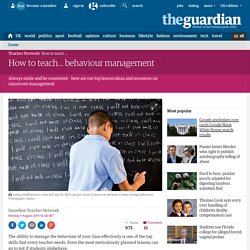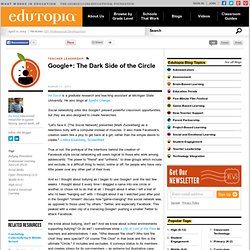

How to teach … behaviour management. The ability to manage the behaviour of your class effectively is one of the top skills that every teacher needs.

Even the most meticulously planned lessons can go to pot if students misbehave. Many practitioners, including newly-qualified teachers, are always on the lookout useful class management techniques especially before the new school year begins, so we've collected a range of useful resources to help you get the best out of your pupils. In Positive ways to manage behaviour, Paul Dix provides a range of techniques for getting your class under control, including: establishing explicit rules and routines, providing students with clear choices around their behaviour, and letting them start each day with a clean sheet.
Further advice on some of the most common behaviour problems can be found in Classroom management strategies. Suitable for students of all ages, the resource covers dealing with pupils who are defiant, use abusive language, refuse to work or make silly noises in class. Google+: The Dark Side of the Circle. Ira Socol is a graduate research and teaching assistant at Michigan State University.

He also blogs at SpeEd Change. Social networking sites like Google+ present powerful classroom opportunities, but they are also designed to create hierarchies. "Let's face it, [The Social Network] presented [Mark Zuckerberg] as a relentless bully with a computer instead of muscles. It also made Facebook's creation seem like a ploy to get back at a girl, rather than the simple desire to create. " -- Mike Eisenberg, ScreenRant True or not, the portrayal of the intentions behind the creation of Facebook-style social networking will seem logical to those who work among adolescents. And so I thought about bullying as I began to use Google+ over the last few weeks. We know about bullying, don't we? The Power to Circle I asked, on Google+, "Who will create your students' circles?
"No, of course not . . . I am not picking on Mr. It isn't just online social networking. Why do I ask? New Technologies Have Pitfalls. Promoting Respectful Schools:Building Safer, Saner Schools. Inviting Students to Learn - ASCD Fall Conference 2011. Carole Hayward In Saturday’s session "Inviting Students to Learn: 100 Tips for Talking Effectively with Your Students," Jenny Edwards presented many strategies from her ASCD book by the same title.

Edwards's strategies are based on the premise that the language that teachers use powerfully affects students’ ability to learn. Studies show that teacher language has a great influence on student learning. “The way you speak to your students is key to creating an inviting learning environment,” Edwards explained. “What might you like for your students to be saying 10, 20, 30, 40, 50 years in the future about how what you said to them influenced their lives and their futures?” Influencing the way students think about themselves is often a function of the language you use.
Edwards provided several key examples: "Even better. " Response: Several Classroom Management Suggestions. How to Create Independent Thinkers. Do you have habits? How about your students? I am sure you can think of a few habits you'd like to break. But are there a few you wish would develop? Although we can't make our students think, we can teach them how to be skillful, creative, and strategic in their thinking.
We do this by helping them develop Habits of Mind (free webinar). At a workshop hosted by Florida ASCD this month, Art Costa led educators in Discovering and Exploring the Habits of Mind. By activating and engaging habits of mind—like persistence, questioning and posing problems, thinking flexibly, finding humor, thinking interdependently, and taking responsible risks—our students become better problem solvers. . : As students learn to articulate the meanings of the habits, they develop greater capacity and can create complex analogies and later connect them to their experiences. : Students are more sensitive to cues from the environment. So what does this look like in the classroom? What Your Rules Say About You - Calgary, AB, Canada, ASCD EDge Blog post.